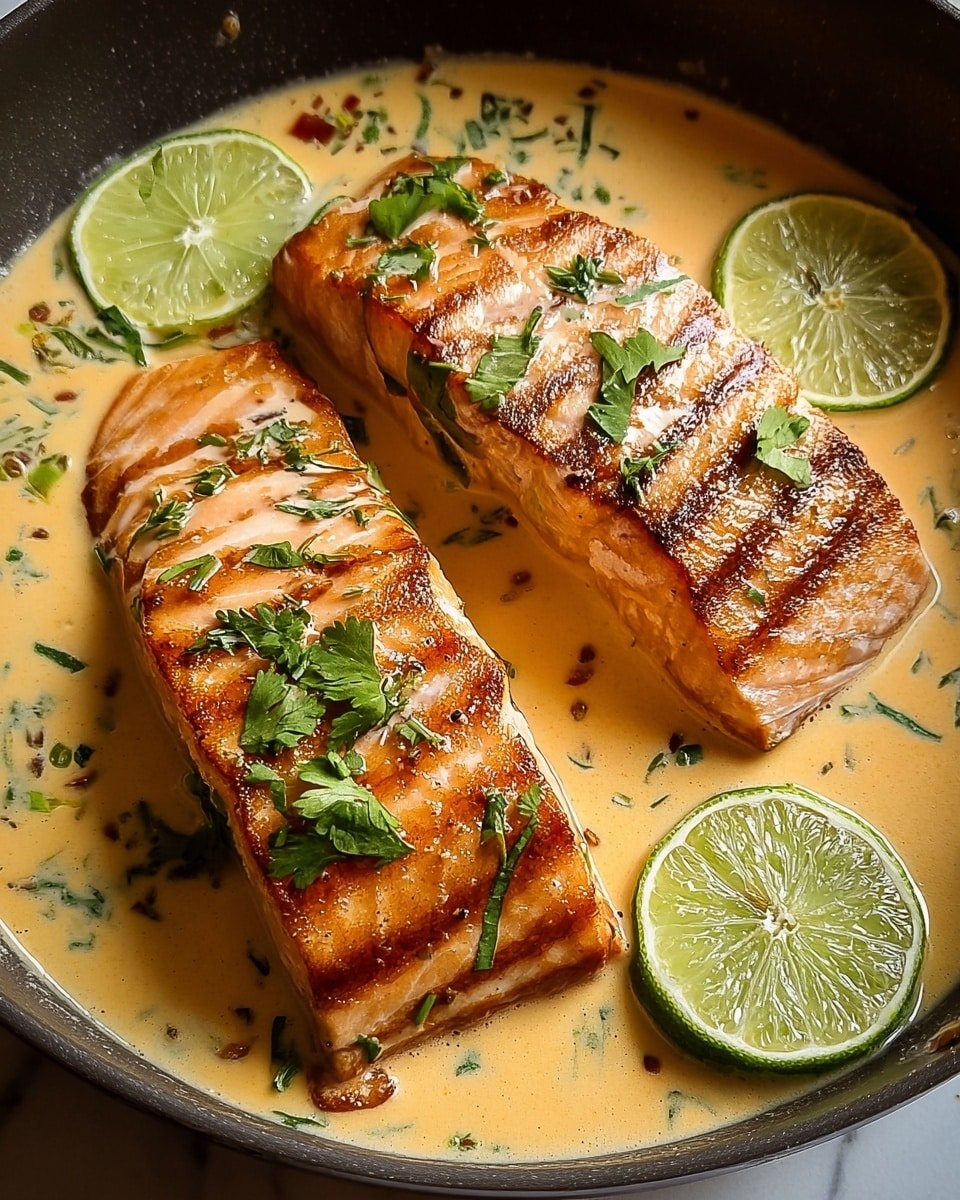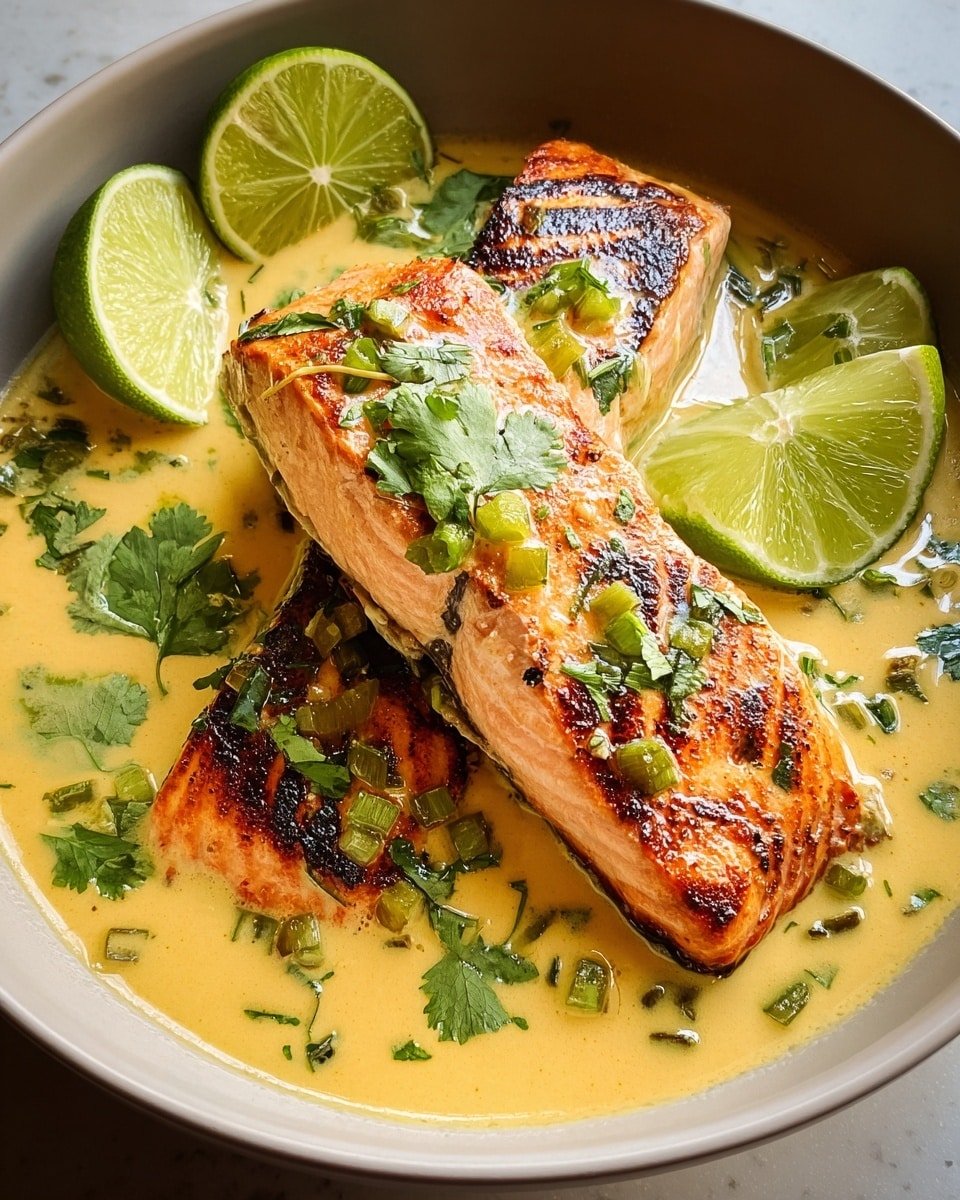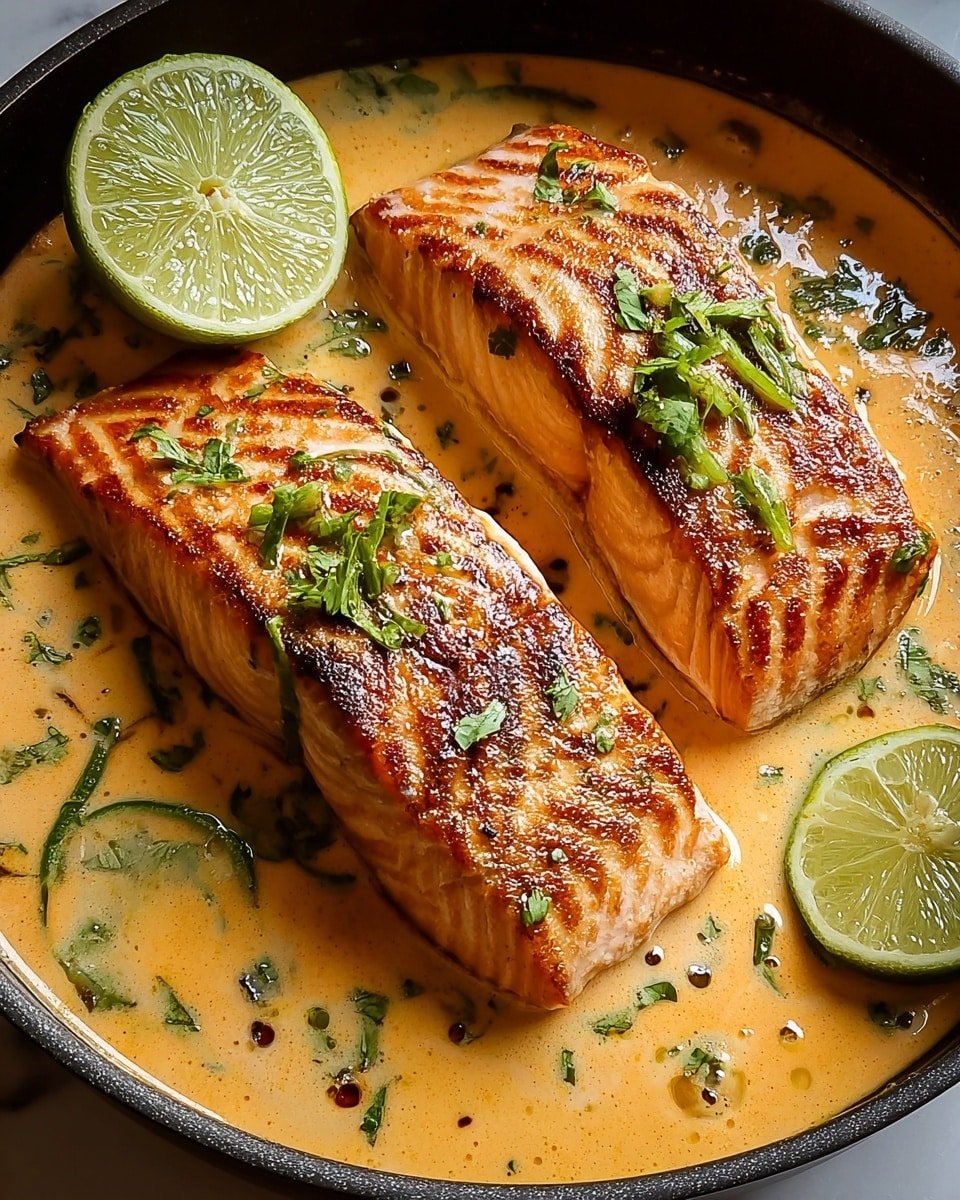
Whenever I make this Poached Salmon in Coconut Lime Sauce Recipe, it instantly feels like a little tropical getaway right in my kitchen. The creamy coconut sauce infused with zesty lime lifts the naturally buttery salmon to a whole new level. I first tried this dish on a lazy weekend and loved how effortlessly elegant it felt—perfect for sharing with friends or just treating myself after a busy week.
You’ll love how the sauce’s bright citrus notes balance the richness of the salmon, and the gentle poaching technique keeps every bite melt-in-your-mouth tender. It’s surprisingly easy, too—no fancy equipment or complicated steps. I promise, you’ll come away confident with a gorgeous, flavorful dish that’s as satisfying on a weeknight as it is for a special brunch.
And don’t worry if you’re new to poaching salmon; I’ll guide you every step of the way to make sure your fish stays perfectly juicy and the sauce sings with fresh flavors. Get ready to impress your taste buds and anyone lucky to join you at the table!
Jump to:
Quick Recipe Snapshot
- What you’ll taste: Creamy coconut richness meets vibrant lime zing with tender, flaky salmon.
- Time & effort: About 25 minutes total; simple steps with minimal fuss.
- Best for: Easy weeknight dinners, casual brunches, or light dinner parties.
Ingredient Notes for Poached Salmon in Coconut Lime Sauce Recipe
Scan this before you start—exact amounts are in the recipe card.
- Key ingredient: Fresh salmon fillets with the skin removed ensure gentle poaching and delicate flakes.
- Supporting ingredient: Full-fat coconut milk gives the sauce a creamy texture and subtle sweetness; you can swap with lite coconut milk but expect a thinner sauce.
- Spice/aroma: Fresh ginger and garlic add warmth and depth—grate ginger finely so it melds smoothly without overpowering.
- Liquid/fat: Fish stock adds umami richness; if unavailable, water works fine, but fish stock enriches the flavor beautifully.
- Optional add-ins: A touch of honey or maple syrup balances the tart lime juice—skip if you prefer a more tangy sauce.
If you’re out of fish stock, using water is perfectly fine—it just makes the sauce a bit lighter but still delicious. Also, feel free to swap soy sauce with tamari for a gluten-free version without losing that salty depth. These tweaks let you customize the recipe to your pantry and preferences.
Cook’s Insight
Exact measurements live in the printable recipe card at the end. Below, I’ll share why each ingredient matters and the tiny tweaks that make Poached Salmon in Coconut Lime Sauce Recipe turn out just right.

Essential Baking Tools
- Large sauté pan or skillet: Choose one with a lid to gently poach the salmon evenly.
- Measuring cups and spoons: For accuracy especially with liquids and seasoning.
- Whisk and spatula: To combine sauce ingredients smoothly and gently spoon sauce over salmon.
- Fish spatula or wide spoon: Helps you carefully lift salmon without breaking it.
- Instant-read thermometer (optional): For perfect salmon doneness, aiming for 145°F (63°C).
- Cutting board and knife: For prepping garlic, onion, ginger, and slicing lime zest.
How to Make Poached Salmon in Coconut Lime Sauce Recipe
Ready to dive in? Let’s break down the steps so you’ll have tender salmon in a zesty coconut lime sauce in no time.
- Heat the aromatics: Warm your olive oil or butter in a skillet over medium heat. Then add garlic, onion, and freshly grated ginger. Sauté gently until soft and fragrant—about 2-3 minutes. You’ll know it’s ready when your kitchen fills with that mouthwatering warm-spicy aroma.
- Build the sauce: Pour in the coconut milk and fish stock (or water). Stir in the soy sauce, lime zest, lime juice, and the optional touch of honey for balanced sweetness. Bring the mixture to a gentle simmer—watch for small bubbles forming at the edges.
- Season and simmer: Season your sauce with salt and pepper, tasting as you go. Let it simmer for 5 minutes so those tropical flavors blend together beautifully and the sauce thickens just slightly.
- Poach the salmon: Nestle the salmon fillets gently into the simmering sauce, skin-side down. Spoon some sauce over each fillet to keep them moist. Cover the pan and let everything poach on low heat for 10-12 minutes. The fish should look opaque, flake easily, and reach an internal temperature of 145°F (63°C).
- Check doneness and serve: If you don’t have a thermometer, use a fork to test: the salmon should easily flake but still feel moist. Spoon sauce and fresh cilantro over the top, and don’t forget the lime wedges for squeezing! The vibrant colors and aromas make this dish a feast for the senses.
Kitchen Shortcuts
- Prep smarter: Mince garlic and grate ginger ahead in a small bowl to streamline cooking.
- Texture control: Poach salmon just until it flakes easily—overcooking dries it out fast.
- Cleanup win: Line your pan with parchment or a silicone liner for easier scrubbing afterward.
- Make it foolproof: Use an instant-read thermometer to nail perfect doneness every time.
How to Serve & Enjoy

- Everyday: Serve over steamed jasmine rice or quinoa for a quick, nourishing meal any night.
- For Guests: Garnish generously with fresh cilantro leaves and a sprinkle of toasted coconut flakes for an impressive presentation.
- Creative Twist: Use leftover salmon and sauce to make flavorful fish tacos with crunchy slaw and avocado slices.
Flavor Boosts & Easy Swaps for Poached Salmon in Coconut Lime Sauce Recipe
- Add fresh chili flakes or sliced bird’s eye chili for a spicy kick without overpowering the lime-coconut combo.
- Swap salmon for cod or tilapia if you want a milder white fish option that poaches just as well.
- Use agave or more maple syrup instead of honey for a vegan-friendly sweetness.
- Mix in julienned bell peppers or snap peas to the sauce just before poaching for added crunch and color.
- Infuse a little lemongrass in the sauce for a citrusy herbal twist that pairs beautifully with coconut.
Make It Ahead & Store It Right
- Make-ahead: Prepare sauce up to 2 days in advance and store in an airtight container in the fridge.
- Cooked salmon: Refrigerate leftovers within 2 hours and consume within 2 days.
- Freezing: Poached salmon can be frozen up to 1 month; thaw overnight in the fridge.
- Reheating: Warm gently on the stove over low heat to avoid drying out the fish.
- Room temp: Best enjoyed fresh but can sit out covered for up to 30 minutes safely before serving.
Reader Questions, Answered
- Can I use frozen salmon for this Poached Salmon in Coconut Lime Sauce Recipe? Absolutely! Just thaw thoroughly and pat dry before poaching to avoid excess moisture in the sauce.
- What if I don’t have fresh lime? Can I use bottled lime juice? Fresh lime offers the best aroma and bright acidity, but bottled works in a pinch—just use a little less and adjust to taste.
- Why poach instead of bake or pan-sear? Poaching gently cooks the salmon in the flavorful sauce, keeping it extra moist and infusing every bite with the coconut lime goodness—super tender and silky texture guaranteed.
- How do I know when the salmon is perfectly cooked? Look for an internal temperature of 145°F (63°C) or test with a fork: it should flake easily but still look moist and opaque.
- Can I make the sauce vegan? Yes! Skip the fish stock and use vegetable broth or water instead to keep it plant-based and still delicious.
Your Turn to Cook!
I can’t wait to hear how your Poached Salmon in Coconut Lime Sauce Recipe turns out. Drop a rating or comment below to share your twists, and be sure to sign up for my newsletter so you never miss a fresh, flavorful recipe coming your way!
Print📖 Recipe
Poached Salmon in Coconut Lime Sauce Recipe
This Poached Salmon in Coconut Lime Sauce is a delicate and flavorful dish featuring tender salmon fillets gently simmered in a creamy, tangy coconut lime sauce infused with garlic, ginger, and fresh lime zest. Perfect for a light yet satisfying meal, it combines the richness of coconut milk with zesty lime and aromatic spices for a tropical-inspired seafood delight.
- Prep Time: 5 minutes
- Cook Time: 20 minutes
- Total Time: 25 minutes
- Yield: 4 servings
- Category: Main Course
- Method: Stovetop
- Cuisine: Fusion (Southeast Asian-inspired)
Ingredients
Salmon
- 4 salmon fillets (about 6 ounces each), skin removed
Sauce
- 1 cup coconut milk (full-fat for creaminess)
- ½ cup fish stock or water
- 1 tablespoon olive oil or butter
- 2 cloves garlic, minced
- 1 small onion, finely chopped
- 1 tablespoon fresh ginger, grated
- Zest of 1 lime
- Juice of 2 limes
- 1 tablespoon soy sauce (or tamari for gluten-free)
- 1 teaspoon honey or maple syrup (optional for a touch of sweetness)
- Salt and pepper, to taste
Garnish
- Fresh cilantro, for garnish (optional)
- Lime wedges, for serving
Instructions
- Heat Oil: In a large skillet or sauté pan, heat the olive oil or butter over medium heat.
- Cook Aromatics: Add the minced garlic, chopped onion, and grated ginger to the pan. Sauté for about 2-3 minutes, until the onions are softened and fragrant.
- Add Liquids: Stir in the coconut milk, fish stock (or water), soy sauce, lime zest, lime juice, and honey (if using). Bring the mixture to a simmer.
- Season the Sauce: Season the sauce with salt and pepper to taste, adjusting the seasoning to your preference. Let it simmer gently for 5 minutes to allow the flavors to meld together.
- Add Salmon Fillets: Gently place the salmon fillets into the simmering sauce, skin-side down. Spoon some of the sauce over the top of the fillets to help them cook evenly.
- Poach Salmon: Cover the pan with a lid and cook for 10-12 minutes, or until the salmon is cooked through and flakes easily with a fork. Be careful not to overcook the salmon, as it should remain moist and tender.
- Check for Doneness: The internal temperature of the salmon should reach 145°F (63°C). If you don’t have a thermometer, check the salmon by gently pressing it with a fork to see if it flakes easily.
- Serve: Garnish with fresh cilantro if desired, and serve with lime wedges alongside the poached salmon and coconut lime sauce.
Notes
- Use full-fat coconut milk for the creamiest sauce; light coconut milk may yield a thinner consistency.
- Fish stock can be substituted with water for a lighter version without compromising too much flavor.
- Adjust the lime juice and zest amounts based on your preferred tartness.
- If you prefer a sweeter sauce, add a bit more honey or maple syrup to taste.
- To ensure even cooking, make sure the sauce simmers gently and avoid boiling vigorously once the salmon is added.
- Serve this dish with steamed rice or sautéed vegetables for a complete meal.


Leave a Reply